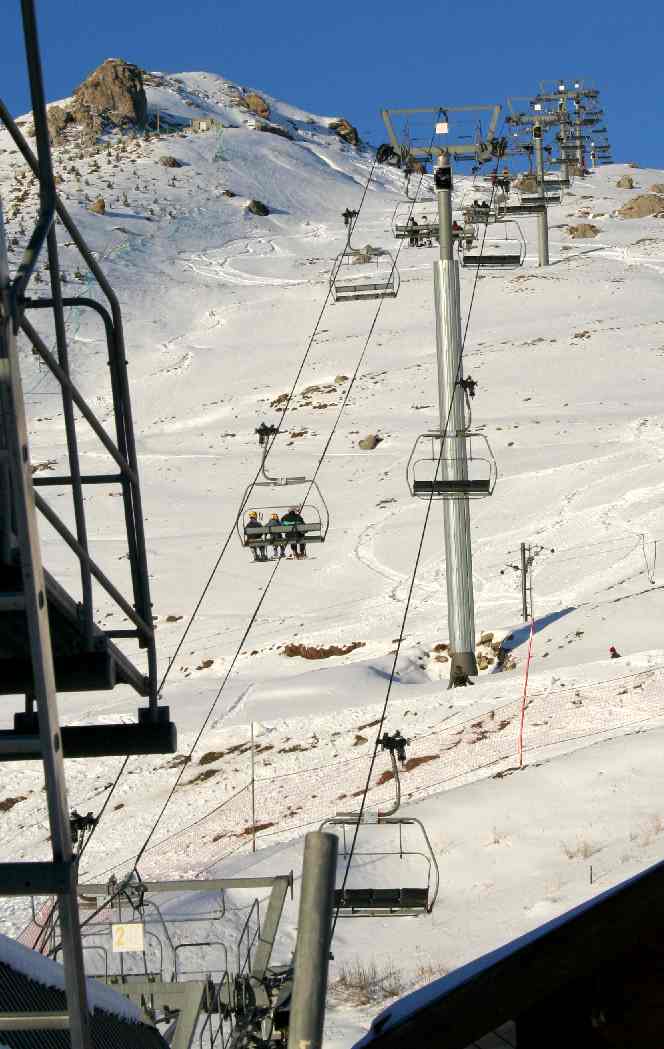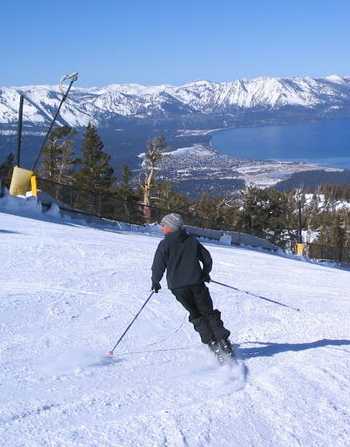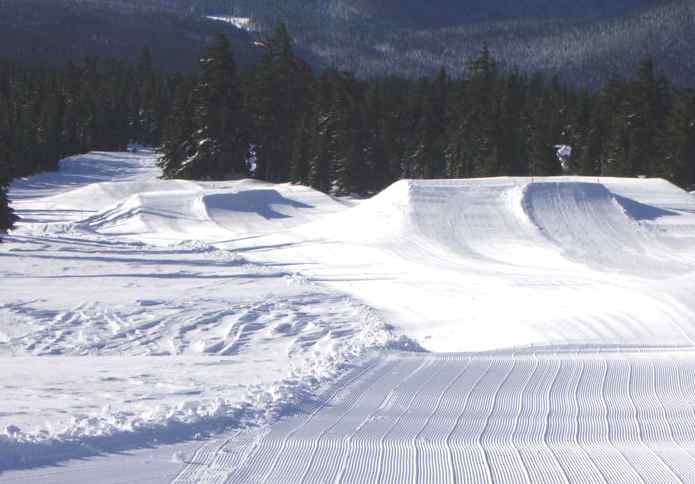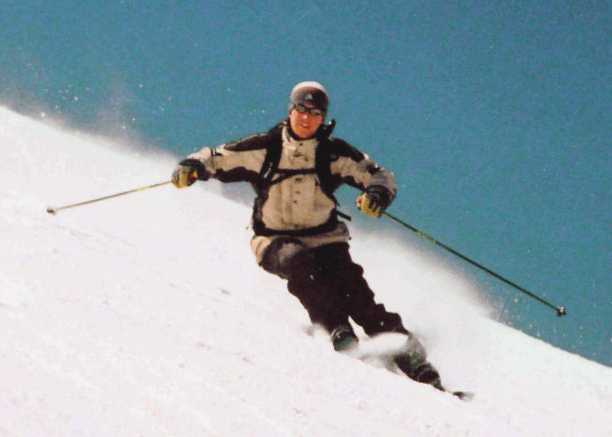|
SKIING
|
||||||||||||||||||||||||||||||||||||||
|
Skiing (technically snow skiing) is the activity of gliding over snow using skis (originally wooden planks, now usually made from fiberglass or related composites), with metal edges, strapped to the feet with ski bindings. Originally used primarily for transportation, snow skiing evolved into a popular recreational and competitive activity during the 20th century. The sport consists of many variations, each of which fits into one of the major categories of alpine skiing, nordic skiing, or telemark skiing.
Ski chair lift French Alps 2007 © NJK
History
Skiing evolved gradually from snowshoeing and originally was a practical way of getting from one place to another in the cold winter. Early forms of skiing resembled today's Nordic, or cross-country, style.
Sondre Norheim is often called the "father of modern skiing". In the 19th century, Norheim invented bindings that enabled the skier to do turns while skiing down hills. This form of skiing was called Slalom (sla lĺm, Norwegian dialect expression for a difficult track) by Norheim and his contemporaries. This form of skiing is now referred to as Telemark skiing or telemarking.
The invention of firmer bindings to anchor the skier's feet to the ski, likely by Austrian Mathias Zdarsky, enabled the skier to turn more effectively and led to the development of Alpine, or Downhill, skiing.
Shortly thereafter, in the early 20th century, Austrian Hannes Schneider pioneered the idea of rotating the body to help steer the skis. Soon this Arlberg technique, named for his home region, spread around the world and helped make skiing a popular recreational activity.
Types of skiing
Many different types of skiing are popular, especially in colder climates, and many types of competitive skiing events are recognized by the International Olympic Committee (IOC), the International Ski Federation (FIS), and other sporting organizations. Skiing is most visible to the public during the Winter Olympic Games where it is a major sport.
In skiing's traditional core regions in the snowy parts of Scandinavia, as well as in places such as Alaska, both recreational and competitive skiing is as likely to refer to the cross-country variants as to the internationally downhill variants.
For most people Worldwide, "skiing" refers to recreational cross-country skiing, whereas in North America many people think of Alpine Skiing where one visits a ski resort, purchases a lift ticket, dons cold-weather clothing, skis, ski boots and ski poles, and embarks on a chairlift, gondola lift, or other means of mechanical uphill transport. Upon reaching the summit, the skier disembarks from the ski lift and travels downhill, propelled by gravity, usually along a marked route known as a piste, "run," "trail," or "slope". Most ski resorts use mechanical equipment to "groom," or pack down and smooth, the snow surface on certain ski trails. Grooming is normally associated with trails of lesser difficulty. Off-piste skiing includes skiing in unmarked or unpatrolled areas either within the ski resort's boundaries or in the backcountry, frequently amongst trees ("glade skiing"), usually in pursuit of fresh fallen snow, known as powder.
Man skiing slope overlooking Lake Tahoe
Skiing or snowboarding outside a ski resort's boundaries, also known as out of bounds skiing, is illegal in some ski resorts, due to the danger of avalanches on the un-patrolled areas; or the cost of search-and-rescue for lost or overdue skiers. France and Canada are two of the few countries permitting this activity. However, lost or overdue backcountry travellers are usually held responsible for the cost of search-and-rescue service if uninsured. Backcountry skiers traveling in steep terrain prone to avalanches are encouraged to take avalanche training, travel with other experienced people, and carry special equipment for self-rescue. It is recommended that skiers make the local ski patrol aware of where they are going if they stray off-piste in case of avalanches or bad weather that could put skiers in danger.
Skiing techniques are difficult to master, and accordingly there are ski schools that teach everything from the basics of turning and stopping safely to more advanced carving, racing, mogul or "bump" skiing and newer freestyle techniques. The venue, speed and technical difficulty associated with the sport can lead to collisions, accidents, hypothermia and other injury or illness, occasionally including death. Regional Ski Patrol organizations, such as the National Ski Patrol in the U.S., exist as a voluntary organization to provide guidance, help, medical assistance and emergency rescue to those in need of it.
For beginning skiers learning under a trained instructor, skiing speeds are low, the terrain is not steep and is often well-manicured, and the risks are relatively low. For extreme skiers, testing their expert abilities against ever more challenging terrain, the risks may be much higher.
In addition to its role in recreation and sport, skiing is also used as a means of transport by the military, and many armies train troops for ski warfare. Ski troops played a key role in retaining Finnish independence from Russia during the Winter War, and from Germany during the Lapland War, although the use of ski troops was recorded by the Danish historian Saxo Grammaticus in the 13th century. The sport of Biathlon was developed from military skiing patrols.
Skiing for people with disabilities
Downhill skiing for people with disabilities is both a recreational pastime and a competitive sport open to those with any manner of cognitive and/or physical disabilities. Adaptations include the use of outriggers, ski tip retention devices, sit-skis like monoskis and bi-skis, brightly colored guide bibs, ski guides, and inter-skier communication systems or audible clues for blind skiers. Recreational skiing programs for people with disabilities exist at mountains across the globe. In the northeastern United States, Maine Handicapped Skiing is one of the largest, operating at Sunday River ski resort. In the western part of the United States, the National Sports Center for the Disabled at Winter Park Resort near Denver, Colorado attracts both first-timers and world-class disabled athletes from Europe, Asia, and North America. Currently the International Paralympic Committee (IPC) and the International Ski Federation (FIS) sanction a number of regional, national, and international disabled skiing events, most notably a World Cup circuit, a Disabled Alpine Skiing World Championships, and the Paralympic Winter Games. Skiing for people with disabilities became popular after World War II with the return of injured veterans.
Ski trail ratings
North America
In North America, a color–shape rating system is used to indicate the difficulty of trails (otherwise known as slopes or pistes).
There is no governing body that assigns difficulty ratings to ski trails. Instead, ski resorts assign ratings to their own trails, marking a given trail according to its relative difficulty when compared with other trails at that resort. As a result, identically-pitched trails at different resorts can have different ratings, leading to concerns that many resorts manipulate the ratings of their slopes to appeal to as wide an audience as possible.
Although slope gradient is the primary consideration in assigning a trail rating, other factors come into play — including trail width, normal snow conditions and whether or not the resort regularly grooms the trail.
Europe
In Europe, pistes are classified by a similar, colour-coded system, although shapes are not used (all ratings are circles). The ratings are:
Alpine slope classification in Europe is less rigidly tied to slope angle than in North America. A lower angle slope may be classified as more difficult than a steeper slope if, for instance, it is narrower and/or requires better skiing ability to carry speed through flatter sections while controlling speed through sharp hairpin turns, off-camber slope angles or exposed rock.
Japan
Japan uses a color-coded system, but shapes do not usually accompany them. Some resorts, mainly those catering to foreigners, use the North American or European color-coding system, adding to the confusion. When in doubt, check the map legend. The usual ratings are:
Japan has more than 600 ski areas (108 in Nagano Prefecture alone), many of them small and family-oriented, so comparisons between slope classifications in Japan and "equivalent" slopes in Europe or North America are minimal.
A terrain park with three jumps, each with a variety of entries - USA Snow and weather
Skiers and snowboarders can encounter a wide range of snow and weather conditions, in part due to the location of specific resorts and global weather patterns at the time.
Natural snow ranges in consistency from very light and fluffy to dense and heavy, depending upon atmospheric conditions as it falls. Snow is often measured by moisture content, or the amount of water in a given volume of snow. Some areas of the United States' Rocky Mountains, for example, can receive considerable amounts of snow with moisture content as low as three to five percent; in the Northeastern United States and the Alps, moisture content is more typically 15 percent or more. Snow made by mechanical snowmaking often has moisture content of 35 percent or more.
Temperatures play a critical role in snow moisture content, but other atmospheric conditions are also relevant. Air currents and other factors determine snow crystal shape; obviously, the farther apart given snow crystals are, the more air is contained in the newly settled snow, resulting in lower net moisture content in a given volume of snow. Snow produced mechanically typically has high relative moisture content and low amounts of loft because the crystal structure resembles small, dense pellets.
Even the fluffiest snow has mass, and snow typically settles under its own weight after time. This is one reason why untouched snow measuring 20 cm on the day it falls might be measured at 15 cm the day following. Snow is also subject to sublimation — a process by which water can go directly from a frozen state to a gaseous state without first melting. It is this same process that ultimately makes ice cubes shrink in a freezer.
There are other factors that impact snow beyond its moisture content and crystal shape, however. Snow is impacted by wind, sunlight, skier traffic, ambient air temperature, relative humidity and grooming equipment; all of these factors combine to change snow crystal shape and density over time.
Thus, skiers and snowboarders typically encounter a wide range of snow conditions over the course of a season. Some of the more common conditions include:
Alpine skier cutting a turn
New developments
The combination of kiteboarding technology with skiing has led to the creation of a new sport, snowkiting. Harnessing the pull of the wind with a kite, snowkiters are able to make very large jumps and travel uphill.
In 1980 the flexible slalom gate known as the Rapidgate was patented by Peter Laehy and Stephan Dag which became the standard for slalom gates in FIS, World Cup and professional ski racing.
Trivia
Skiing is one of the few words in the English language that contains two "i"s in a row.
Skiing topicsTypes of skiing
Turning techniques
Equipment
Competition events
Alpine events
Nordic events
Skiing organizations
International organizations:
National organizations:
Ski safety
Here are some valuable tips to consider before going out skiing.
First, skiiers should be fit for this activity, as injury could occur easily. Just like other sports, good skiiers warm up before starting. This also reduces the probability that injury will occur.
Assistance is available. If a skiier feels that they are not experienced or capable enough to safely ski, there are almost always experts and instructors available for assistance and instruction. Skiing can be a dangerous activity, so knowledge of skiing's fundamentals is imperative. Knowing one's limitations is the first step in NOT getting injured.
Safe skiing equipment is a must. All equipment should be in good condition and properly fitted.
Here are some tips on what to bring for skiing:
LINKS and REFERENCE
Appendix G: Mountain Specifications Summary, Draft Environmental Impact Statement for The Timberline Express Proposal (pdf) 26. USDA, U.S. Forest Service, Mt. Hood National Forest (March 2005).
Ski resort snow slopes and lifts @ Les Orres, France 2007
A - Z SPORTS INDEX
A taste for adventure
A heartwarming adventure: Pirate whalers V Conservationists with a ŁBillion dollars riding on the conclusion
|
||||||||||||||||||||||||||||||||||||||
| This website is Copyright © 1999 & 2020 Max Energy Limited an educational charity working hard for world peace. The bird logos and names Solar Navigator, Blueplanet Ecostar and Utopia Tristar are trademarks. All rights reserved. All other trademarks are hereby acknowledged. |










